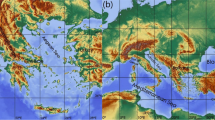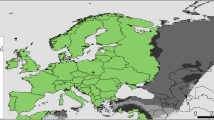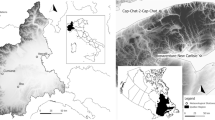Abstract
Climatological observing window (COW) is defined as a time frame over which continuous or extreme air temperature measurements are collected. A 24-h time interval, ending at 00UTC or shifted to end at 06UTC, has been associated with difficulties in characterizing daily temperature extrema. A fixed 24-h COW used to obtain the temperature minima leads to potential misidentification due to fragmentation of “nighttime” into two subsequent nighttime periods due to the time discretization interval. The correct identification of air temperature extrema is achievable using a COW that identifies daily minimum over a single nighttime period and maximum over a single daytime period, as determined by sunrise and sunset. Due to a common absence of hourly air temperature observations, the accuracy of the mean temperature estimation is dependent on the accuracy of determination of diurnal air temperature extrema. Qualitative and quantitative criteria were used to examine the impact of the COW on detecting daily air temperature extrema. The timing of the 24-h observing window occasionally affects the determination of daily extrema through a mischaracterization of the diurnal minima and by extension can lead to errors in determining daily mean temperature. Hourly air temperature data for the time period from year 1987 to 2014, obtained from Toronto Buttonville Municipal Airport weather station, were used in analysis of COW impacts on detection of daily temperature extrema and calculation of annual temperature averages based on such extrema.

















Similar content being viewed by others
Notes
This period ends at the time of subsequent sunrise plus 1 h, to account for thermal inertia of the atmosphere.
Solar declination varies from −23° 26′ (northern hemisphere summer) to +23° 26′ (northern hemisphere winter).
References
Bonacci O, Zeljkovic I, Sakic Trogrlic R, Milkovic J (2013) Differences between true mean daily, monthly and annual air temperatures calculated with three equations: a case study from three Croatian stations. Theor Appl Climatol 114:271–279. doi:10.1007/s00704-012-0830-8
Collison P, Tabony RC (1984) The estimation of mean temperature from daily maxima and minima. Meteorological Magazine, London 113:329–337
Gough WA, He D (2015) Diurnal temperature asymmetries and fog at Churchill, Manitoba. Theor Appl Climatol 121:113–119. doi:10.1007/s00704-014-1227-7
Harris SA, Pedersen JH (1995) Comparison of three methods of calculating air temperature from electronic measurements. Z Geomorph 39:203–210
Hartzell FZ (1919) Comparison of methods for computing daily mean temperatures: effect of discrepancies upon investigations of climatologists and biologists. Mon Weather Rev 47:799–801
Reicosky DC, Winkelman LJ, Baker JM, Baker DG (1989) Accuracy of hourly air temperatures calculated from daily minima and maxima. Agric For Meteorol 46:193–209
Trewin B (2004) Effects of changes in algorithms used for the calculation of Australian mean temperature. Aust Meteorol Mag 53:1–11
Vincent LA, Xiolan LW, Milewska EJ, Hopkinson R, Malone R (2009) Bias in minimum temperature introduced by a redefinition of the climatological day at the Canadian stations. J Appl Meteorol Climatol 48:2160–2168. doi:10.1175/2009
Vincent LA, Xiolan LW, Milewska EJ, Wan H, Yang F, Swail V (2012) A second generation of homogenized Canadian monthly surface air temperature for climate trend analysis. J Geo Research 117:D18110. doi:10.1029/2012JD017859
Weber RO (1993) Influence of different daily mean formulas on monthly and annual averages on temperature. Theor Appl Climatol 47:205–213
Weiss A, Hays CJ (2005) Calculating daily mean temperatures by different methods: implications from a non-linear algorithm. Agric For Meteorol 128:57–65
Zeng X, Wang A (2012) What is monthly mean land surface temperature? Eos 93(15):156–157
Author information
Authors and Affiliations
Corresponding author
Rights and permissions
About this article
Cite this article
Žaknić-Ćatović, A., Gough, W.A. A comparison of climatological observing windows and their impact on detecting daily temperature extrema. Theor Appl Climatol 132, 41–54 (2018). https://doi.org/10.1007/s00704-017-2068-y
Received:
Accepted:
Published:
Issue Date:
DOI: https://doi.org/10.1007/s00704-017-2068-y




